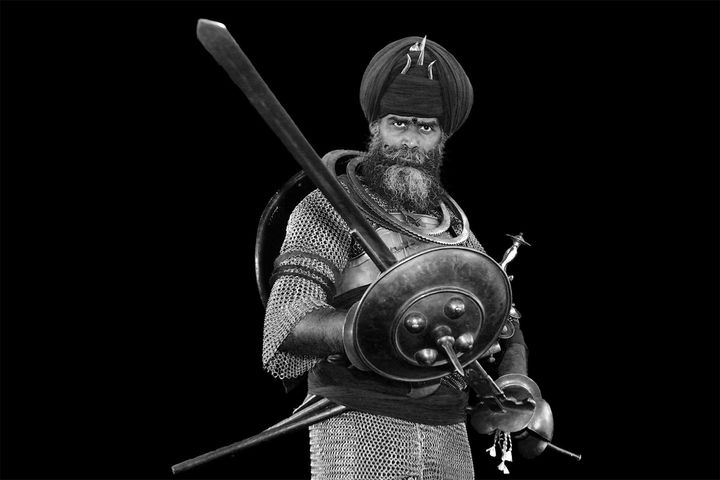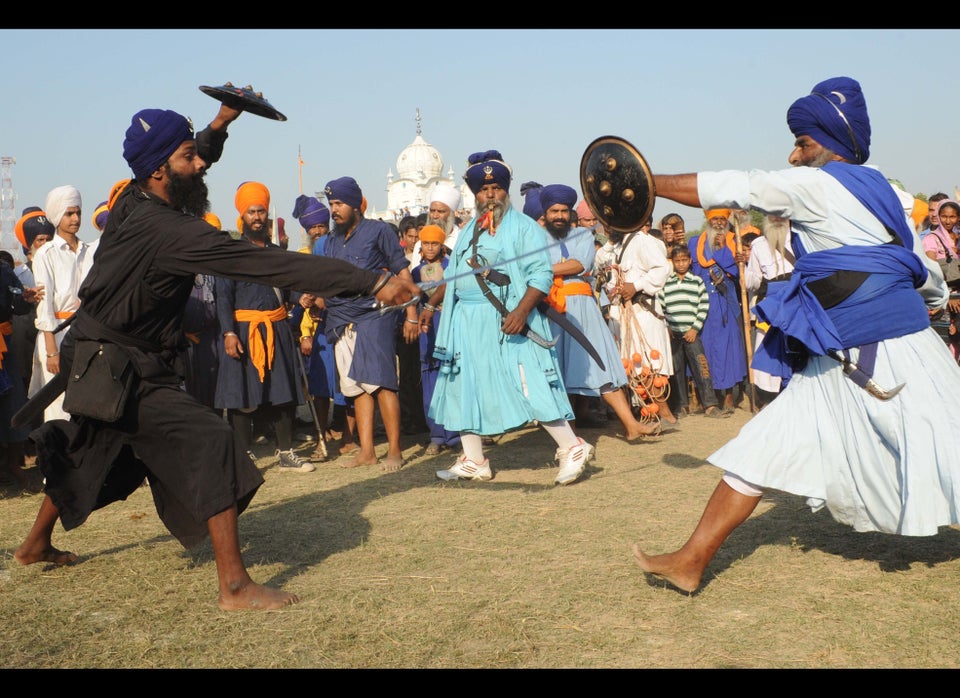
On a sleepy Saturday afternoon in Slough, a borough west of London, Nidar Singh Nihang knows how to keep a group of young men awake.
Inside an empty hall of a church in London Road, Singh Nihang is an authoritative figure. As 20 men, most of them from the Sikh community, surround him in a semi-circle, he demonstrates some self-defence skills. With subtle hand and body movements, he exhibits a form of martial art that he has mastered over 25 years.
But more than 5,000 years after its inception, this form of Sikh martial art known as Shastar Vidiya could soon be relegated to the pages of a history book. There aren't many practitioners and there is a sole surviving master who embodies the technical and traditional expertise: Singh Nihang.
"My aim as a Gurudev [teacher] is to ensure the art, in all its totality, survives," says Nihang Singh.
In Slough, throughout the three-hour session, the man with an intimidating body structure standing at 6-feet-one-inch, explains about the various techniques and also history behind Shastar Vidiya to casually dressed men, most of them in their traditional turban and beard.
"It's a science of weapons," he says, pausing it to describe it more eloquently, "which involves advancing upon the enemy, hitting in a striking range, misaligning his strikes and cutting them down."
As his students engage in different unarmed fighting techniques, an array of weapons neatly lay on the table. Singh Nihang steps forward, picks up a Maddu, a small weapon akin to a knuckleduster, and tells how it was used during wartime to attack the enemies.
"In the old days, you had to fight people to show your art. Nowadays we can be sensible. We can demonstrate so we can show the art and science behind it," he says.
Singh Nihang himself is draped in a blue Chola, a kurta-like robe, with white Kachera, knee-length breaches, and sneakers. His sword and a traditional dagger are neatly tucked between the blue Kamarkasar (cloth belt) wrapped around his waist.
His traditional get-up and a long beard with streaks of white hair might give an intimidating first impression, but he isn't as fierce as he appears. (Read more after these photos of the Sikh martial art, Gatka, in action...)
Singh Nihang is a combination of wit and a wealth of knowledge. In between his classes, he speaks of history and heritage associated with Shastar Vidiya and doesn't hesitate to make his students smile. He likes to keep the atmosphere "relaxed but serious."
"He's always coming out with jokes and keeps the class light-hearted," says Jas Singh, a students in Slough. Dressed in sports trousers and an England football jersey, the 24-year-old project manager at a construction company, chose to learn Shastar Vidiya because "it had a link to Sikh culture." Five years later, Jas says Singh Nihang has helped him come closer to the art, science and culture behind Shastar Vidiya and also his heritage.
As the master sits down after his class, he is still energetic speaking about the art he discovered in 1984. He takes a memory train back to Jalandhar in northern India.
Stroking his beard, flashing an apparent smile, he mentions his 80-year-old teacher who spotted him at a fair and asked him if he wanted to learn. A tall teenager with striking physical features agreed.
He tells the story, sprinkling some Punjabi words in between yet retaining his English accent.
"He gave me a stick and told me to hit him, but before I knew it, I was on the floor and he had the stick," he says in a single sentence.
"The science of what he was doing, I didn't understand then," says Singh Nihang, who then stayed back in India for 11 years. "But now I know the art and also the culture behind the art."
For 42-year-old Iqbal Singh, a Bruce Lee fan, learning the Shastar Vidiya is also understanding about his Indian and Sikh heritage.
"As a parent, I need my kids to know their roots and this is an all encompassing package to educate them," an IT consultant and Singh Nihang's student for five years says. He defines his master as a "living entity and a torch bearer whose life is on a mission."
And it's not an easy duty. Singh Nihang trains from 8:30 p.m. to 1:30 a.m. every day and also maintains a meditation schedule.
"This art is more than physical," the master says. "It's an intellectual pursuit. On one hand we are preserving history and culture and on other we are transmitting them."
But passing the skills also means preparing the next master. The more than 100 Sikh, Muslim and Christian students in Singh Nihang's classes throughout the U.K., he says, belongs to the "wrong generation" of becoming the master.
He thinks the younger generation, the kids in his class, including his 7-year-old son, have more chances of succeeding him. They have more time to be shaped into the technical, cultural and historical side, qualities that a master should embody.
The 44-year-old's passion and commitment for the art's protection and perseverance is apparent. While he is teaching or talking about it, his skills and depth of knowledge is evident.
Amrit Pal Singh, a 25-year-old engineer, speaks fondly of his master: "The passion he has is addictive and he conveys it very well to his students," he says. "He is very inspirational that he dedicates his life to the art."
However, not everyone agrees. Singh Nihang has received numerous death threats from Sikh fundamentalists who disagree with the ideologies of Shastar Vidiya.
But the determined and assertive warrior gives an uncanny smile, explaining that his critics are not aware of the wider spectrum of their own culture. Despite the mounting problems and challenges of saving a historical martial art with a cultural significance and finding a successor, he is still nurturing the knowledge he acquired in 1984. Finding a successor, he says, will not be an end to his pursuit.
"I'll never retire," he delivers promptly in a firm tone. "If I die and I can come back, I'll train. We're not meant to retire."
